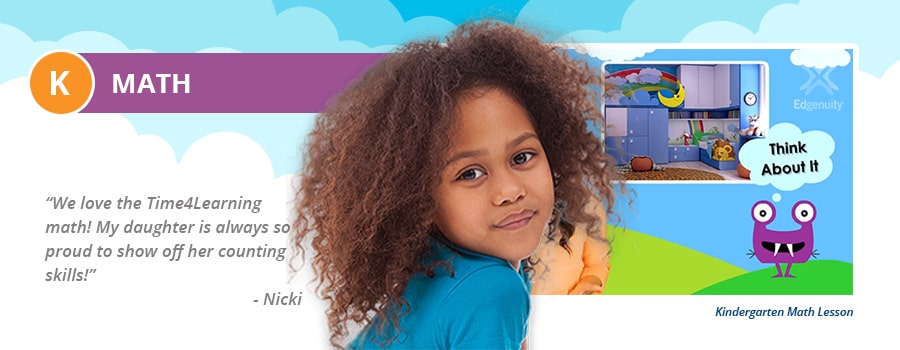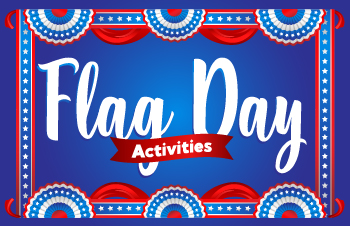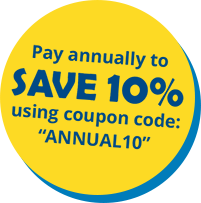Kindergarten Online Math Curriculum and Lesson Plans
The Time4Learning kindergarten math lessons put a fun spin on learning important foundational skills for the youngest of students. In addition to engaging, interactive activities that teach the lessons, each of the chapters features an overarching theme such as safari, playtime, and cooking.
This page provides information on what kindergarten math a student should know, math objectives for the year, and why Time4Learning is the best choice to help your child reach all of the kindergarten math goals and objectives.
What Math Should a Kindergarten Student Know?
Kindergarten math is all about becoming familiar with the basics and setting a solid foundation. Students will learn to count and recognize numbers, identify shapes and their attributes, add and subtract numbers, and complete patterns.
Below are some of the other skills that a student should know in kindergarten math.
- Create, describe and compare 2-D and 3-D shapes
- Compare groups using the terms greater, less, fewer, more
- Use tally charts and picture graphs to represent numbers
- Recognize that larger numbers are made up of smaller numbers
- Order events in a sequence
Kindergarten Math Objectives
For most students, kindergarten is their first official year of schooling. Gaining a solid understanding of basic concepts now, will help them feel confident and prepared as they learn new math skills in the years to come. That’s why it’s so important that students use a comprehensive curriculum, like Time4Learning, to help them master these concepts and reach all their kindergarten math goals and objectives.
Below are some of the math objectives a kindergarten math curriculum should help your child achieve.
- Count objects up to 20
- Use an analog and digital clock to identify time to the nearest hour
- Identify pennies, nickels, dimes, and quarters and know their value
- Compare the length and weight of objects
- Explore properties of addition and subtraction
Time4Learning’s Kindergarten Math Lesson Plans
Functionality of buttons and interactions, and practice questions from lessons based on objectives.
Recognize likenesses and differences between pairs of items.
Sort objects by appearance (e.g., color, size, and shape). Recognize items that are the same and different. Extend and identify a repeating pattern.
Sort representations of living things by appearance. Create items with given attributes. Recognize one-to-one correspondence.
Align sorted objects to determine whether a one-to-one match exists. Determine which set has more or fewer members when a one-to-one match does not exist. Create and interpret picture-graph displays.
Copy, continue, and complete patterns involving two attributes.
Chapter Test: Under the Sea
Use positional words to describe vertical and horizontal relationships. Recognize that more than one term may be appropriately used to describe a positional relationship. Create a positional relationship by following directions.
Use positional words to direct investigations that occur in different locations. Use positional words to describe locations.
Recognize that vertical and horizontal relationships are often determined by point of view. Recognize that individual items may each appear different from different perspectives.
Investigate the features of a circle, triangle, square, and rectangle, and identify their presence in contextual settings. Identify likenesses and differences between pairs of shapes. Construct shapes.
Analyze, compare, create, and compose two- and three-dimensional shapes, in different sizes and orientations, using informal language to describe their similarities, differences, parts, and other attributes.
Construct and/or complete simple scenes formed with plane figures. Construct, complete, and describe patterns formed with plane figures.
Chapter Test: Playtime in the Park
Recognize that objects can be counted and represented by numerals. Recognize that cardinal numbers represent a quantity (numbers 1-5). Read and represent numbers 1-5. Recognize that different arrangements represent the same quantity (numbers 1-5).
Compare groups to determine more/greater/less/fewer. Use one-to-one correspondence when comparing sets. Recognize the concept of zero as representing an empty set. Construct and interpret picture graphs.
Recognize that objects can be counted and represented by numerals (0-20). Recognize that cardinal numbers represent a quantity (numbers 0-20). Read, write, and represent numbers 0-20. Recognize that different arrangements represent the same quantity (numbers 0-20).
Use one-to-one correspondence to represent and compare quantities of 0-10. Use tally charts and picture graphs to represent 0-10. Recognize sequence of numbers on a number line. Describe position in a sequence of whole numbers on a number line up to 10.
Recognize that larger numbers are formed from combinations of smaller numbers. Explore addition models. Recognize that smaller numbers are formed by taking apart sets. Informally explore subtraction models.
Chapter Test: Let’s Go On a Safari
Use a calendar as a tool to identify months, days, and dates. Use a calendar as a tool to identify today, yesterday, and tomorrow. Identify parts of a day (morning, afternoon, evening). Use an analog clock to identify time to the nearest hour. Use a digital clock to identify time to the nearest hour. Order events in a sequence. Identify temperature using a thermometer.
Identify penny, nickel, dime, quarter. Identify value of penny, nickel, dime, quarter. Combine coins to make values up to 10 cents.
Compare the length of objects. Identify and correct common errors in linear measurement. Estimate and measure length using nonstandard units. Measure length using standard units.
Separate items into equal parts through an active comparison of their length. Informally explore commonly used fractional parts of a whole (fourths, thirds, halves).
Compare the weight of objects. Compare the capacity of objects. Recognize tools of measurement. Informally explore the concept of area.
Use a calendar as a tool to identify months, days, and dates. Use a calendar as a tool to identify today, yesterday, and tomorrow. Identify parts of a day (morning, afternoon, evening). Use an analog clock to identify time to the nearest hour. Use a digital clock to identify time to the nearest hour. Order events in a sequence. Identify temperature using a thermometer. Identify penny, nickel, dime, quarter. Identify value of penny, nickel, dime, quarter. Combine coins to make values up to ten cents. Compare the length of objects. Identify and correct common errors in linear measurement. Estimate and measure length using nonstandard units. Measure length using standard units. Separate items into equal parts through an active comparison of their length. Informally explore commonly used fractional parts of a whole (quarters, thirds, halves). Compare the weight of objects. Compare the capacity of objects. Recognize tools of measurement. Informally explore the concept of area.
Chapter Test: What’s Cooking?
Read and represent numbers 11-20. Recognize that larger numbers are formed from combinations of smaller numbers (11-20). Demonstrate understanding of conservation of number (recognizing that size does not affect number). Explore numbers 0-100. Explore number patterns, counting by 1s, 2s, 5s, and 10s.
Use data to create picture graphs. Use data to create bar graphs. Interpret data from graphs and use it to solve problems.
Understand basic concepts of chance and probability. Describe events as likely or unlikely.
Recognize that larger numbers are formed from combinations of smaller numbers. Explore addition models. Explore properties of addition. Use addition number sentences to record the combining of sets. Solve addition number sentences.
Explore subtraction models. Explore properties of subtraction. Use number sentences to record subtraction. Solve subtraction number sentences.
Use data to create picture graphs. Use data to create bar graphs. Interpret data from graphs and use it to solve problems. Use data to create picture graphs. Use data to create bar graphs. Interpret data from graphs and use it to solve problems. Understand basic concepts of chance and probability. Describe events as likely or unlikely. Explore addition models. Explore properties of addition. Use addition number sentences to record the combing of sets. Solve addition number sentences. Explore subtraction models. Explore properties of subtraction. Use number sentences to record subtraction. Solve subtraction number sentences.
Chapter Test: Numbers in the Neighborhood
Scope & Sequence Copyright © 2025 Edgenuity, Inc. All rights reserved.
Why Choose Time4Learning Kindergarten Math Homeschool Curriculum
Setting up students for success in math or any other subject starts as early as kindergarten. Helping them master counting, shapes, basic addition and subtraction will have a big impact on their performance in later years.
Time4Learning’s kindergarten math curriculum uses bright, colorful and engaging activities to make math fun and enjoyable for the little ones. Students are able to log in on their time and progress at their own pace. The curriculum is simple to follow and material is presented in a suggested sequence that builds on itself.
Parents have access to lesson plans, student planners, and plenty of resources to make homeschooling simple. In addition, our automated grading and recordkeeping system keeps track of all of your child’s work and makes it simple to print reports and create homeschool portfolios. And if you plan on using the kindergarten math curriculum as a supplement, you will have full access to these features as well.
Interested in other kindergarten subjects? Learn more about our online kindergarten curriculum, designed to teach your student their fundamental concepts.






